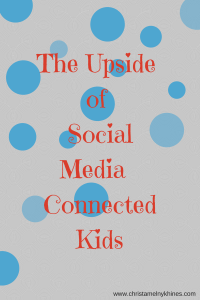 We are often treated to salacious stories about the shadowy side of social media. And while it is true that bad things can happen (and they do, both online and offline), consider the many positive ways kids can use social media.
We are often treated to salacious stories about the shadowy side of social media. And while it is true that bad things can happen (and they do, both online and offline), consider the many positive ways kids can use social media.
As a space for creativity. If your child has a passion for photography, artwork or writing, she might like to post her work on her own blog. Or she could invite a couple of friends and create a community blog. This is good practice for them to set up rules about the content they plan to post, ways to keep their material and themselves safe, and who they will invite to see their blog. They can make the blog public; private for just family and friends; or lock it down for their own use.
Tip: Even if your child’s blog is private, remove geographic identifying information from photos and profile information and have her use her first name or a pseudonym only.
To raise awareness. Some kids use social media to promote causes that are close to their hearts.
A group of Kansas City students, who are part of a non-profit organization for at-risk kids called Minddrive, restore old cars into futuristic looking electric cars. In 2013, using the power of Facebook and YouTube likes and hashtagging on Twitter and Instagram, the team programmed the car to recognize social media connections. Muscled by their social media fuel, they drove the car from KC to DC. The teens not only gained engineering and automotive skills, they learned valuable online and in-person communication skills as they interacted with people from all over the world who were interested in the project.
Tip: Complement tweets and posts with video interviews and short informational clips about the project to educate and share with your audience. This is a great way to practice public speaking skills in front of a camera.
To connect with friends who share common interests. Social media can be sort of like summer camp. Summer camp gives kids the opportunity to hang out with other kids outside of their immediate community who share common interests. They can just be themselves without the baggage of labels and the social barriers that crop up at school. Whenever you spend time with your tribe–people who understand your passion–you grow more self-confident and feel less alienated.
Tip: Most popular social networking sites require that participants are 13 years or older. Have your teen hang out on the site before diving in to get a feel for the rules, how the moderator manages negativity and to ensure it is a good fit. Social networks for younger kids include YourSphere.com and ClubPenguin.com.
For learning. With your oversight, YouTube is a fun way for elementary kids to conduct research for school projects or learn more about topics that interest them. Many teachers also use Twitter and Skype to connect their classrooms with experts in the field who their students can interview.
Tip: Set YouTube to safety mode if you are concerned about content your child might view. For more on YouTube safety, visit my recent post.
For your kids to benefit the most from social media, make sure they have firm boundaries in place, keep their interactions positive and aren’t confining their social life to online interactions only. Role model and create a digital citizenship contract with them to ensure that they understand your rules and expectations for online conduct.
What do you see as the upside of social media?

Pingback: Welcome to the Jungle: Taming Technology in the Life of Your Child
Pingback: Welcome to the Jungle: Taming Technology in the Life of Your Child | Kids With Hearing Loss